Effects of Natural Factors and Production Management on the Soil Quality of Agricultural Greenhouses in the Lhasa River Valley, Tibetan Plateau
Abstract
:1. Introduction
2. Materials and Methods
2.1. Study Area
2.2. Experimental Design, Soil Sampling, and Analysis
2.3. Data Sources
2.4. Methods for the Analyses
2.4.1. Soil Fertility Quality Index
2.4.2. Relative Change Rate
2.4.3. Geographical Detection of the Factors and Their Interactions
2.5. Data Analysis and Processing
3. Results
3.1. Descriptive Statistical Analysis of Soil Physicochemical Properties
3.2. Identification and Analysis of Soil Quality Indicators with Significant Differences
3.3. Influence Factors of Soil Quality Improvements and Declines
3.3.1. Factors Contributing to Soil pH Decline and Their Interactions
3.3.2. Contributions and Interactions of Factors Influencing Soil Salinity Accumulation
3.3.3. Influential Factors for Soil Nutrient Improvement and Their Interaction Effects
4. Discussion
4.1. Significant Differences in Soil Quality Between Agricultural Greenhouses and Open Croplands
4.2. Dominant Factors of Soil Quality Differences
4.3. Adjustment Strategy for Agricultural Greenhouses
4.4. Implications and Limitations
5. Conclusions
Author Contributions
Funding
Data Availability Statement
Conflicts of Interest
Appendix A
| County | Sample Area | Geometric Position (°) | Average Elevation (m) | Slope (°) | Average Planting Year (y) | Main Cultivars |
|---|---|---|---|---|---|---|
| Quxu | S1 | E 90.79 N 29.38 | 3588.75 | 0–4 | 6 | Lycopersicon esculentum, Spinacia oleracea |
| S2 | E 90.95 N 29.54 | 3609.75 | 2–10 | 16 | Lycopersicon esculentum, Cucurbita moschata | |
| Doilungdeqen | S3 | E 90.82 N 29.74 | 3784.00 | 0–4 | 11 | Cucumis sativus, Capsicum annuum |
| S4 | E 90.74 N 29.82 | 3789.50 | 0–2 | 4 | Capsicum annuum | |
| S5 | E 90.83 N 29.72 | 3766.00 | 0–2 | 3 | Capsicum annuum, Lactuca sativa | |
| S6 | E 90.95 N 29.68 | 3700.20 | 0–6 | 4.8 | Spinacia oleracea, Lactuca sativa. | |
| S7 | E 90.95 N 29.68 | 3688.00 | 0–6 | 3 | Chrysanthemum coronarium | |
| S8 | E 90.99 N 29.61 | 3660.00 | 0–2 | 6 | Spinacia oleracea, Coriandrum sativum | |
| Chengguan | S9 | E 91.16 N 29.70 | 3706.50 | 0–2 | 9.5 | Oenanthe javanica, Ipomoea aquatica |
| S10 | E 91.26 N 29.67 | 3673.40 | 0–4 | 11 | Luffa aegyptiaca, Vigna unguiculata | |
| S11 | E 90.25 N 29.67 | 3672.67 | 4–6 | 7.67 | Solanum melongena, Lablab purpureus | |
| S12 | E 91.24 N 29.67 | 3675.00 | 2–6 | 10.5 | Ipomoea aquatica, Allium fistulosum | |
| S13 | E 91.22 N 29.67 | 3668.33 | 0–6 | 13.3 | Allium fistulosum | |
| S14 | E 91.23 N 29.64 | 3674.50 | 0–2 | 8 | Capsicum annuum var. grossum, Brassica chinensis | |
| S15 | E 91.25 N 29.64 | 3687.67 | 0–4 | 7 | Lycopersicon esculentum | |
| Dagze | S16 | E 91.38 N 29.70 | 3701.00 | 0–2 | 1 | Cucumis sativus |
| S17 | E 91.31 N 29.66 | 3691.00 | 0–6 | 3 | Brassica parachinensis, Capsicum annuum | |
| Lhunzhub | S18 | E 91.26 N 29.89 | 3727.50 | 0–2 | 11 | Cucumis sativus, Raphanus sativus |
| S19 | E 91.26 N 29.29 | 3721.50 | 2–4 | 14 | Cucurbita pepo, Lactuca sativa var. capitata | |
| S20 | E 91.26 N 29.89 | 3746.83 | 0–2 | 6 | Cucurbita pepo, Cucumis sativus, Brassica pekinensis | |
| S21 | E 91.44 N 29.81 | 3737.00 | 0–2 | 6 | Lactuca sativa var. angustata, Cucurbita pepo | |
| Maizhokunggar | S22 | E 91.79 N 29.81 | 3853.00 | 0–2 | 6.33 | Lactuca sativa, Cucurbita pepo |
| S23 | E 91.77 N 29.82 | 3843.40 | 0–4 | 7 | Solanum melongena, Brassica oleracea var. capitata | |
| S24 | E 91.76 N 29.82 | 3834.00 | 0–2 | 9 | Capsicum annuum | |
| S25 | E 91.75 N 29.83 | 3821.00 | 0–2 | 9 | Capsicum annuum |
| Soil Indicators | Common Factor Variance | Weight |
|---|---|---|
| SOM | 0.774 | 14.05% |
| TN | 0.894 | 16.23% |
| TP | 0.835 | 15.15% |
| TK | 0.662 | 12.01% |
| AN | 0.900 | 16.34% |
| AP | 0.809 | 14.69% |
| AK | 0.635 | 11.53% |
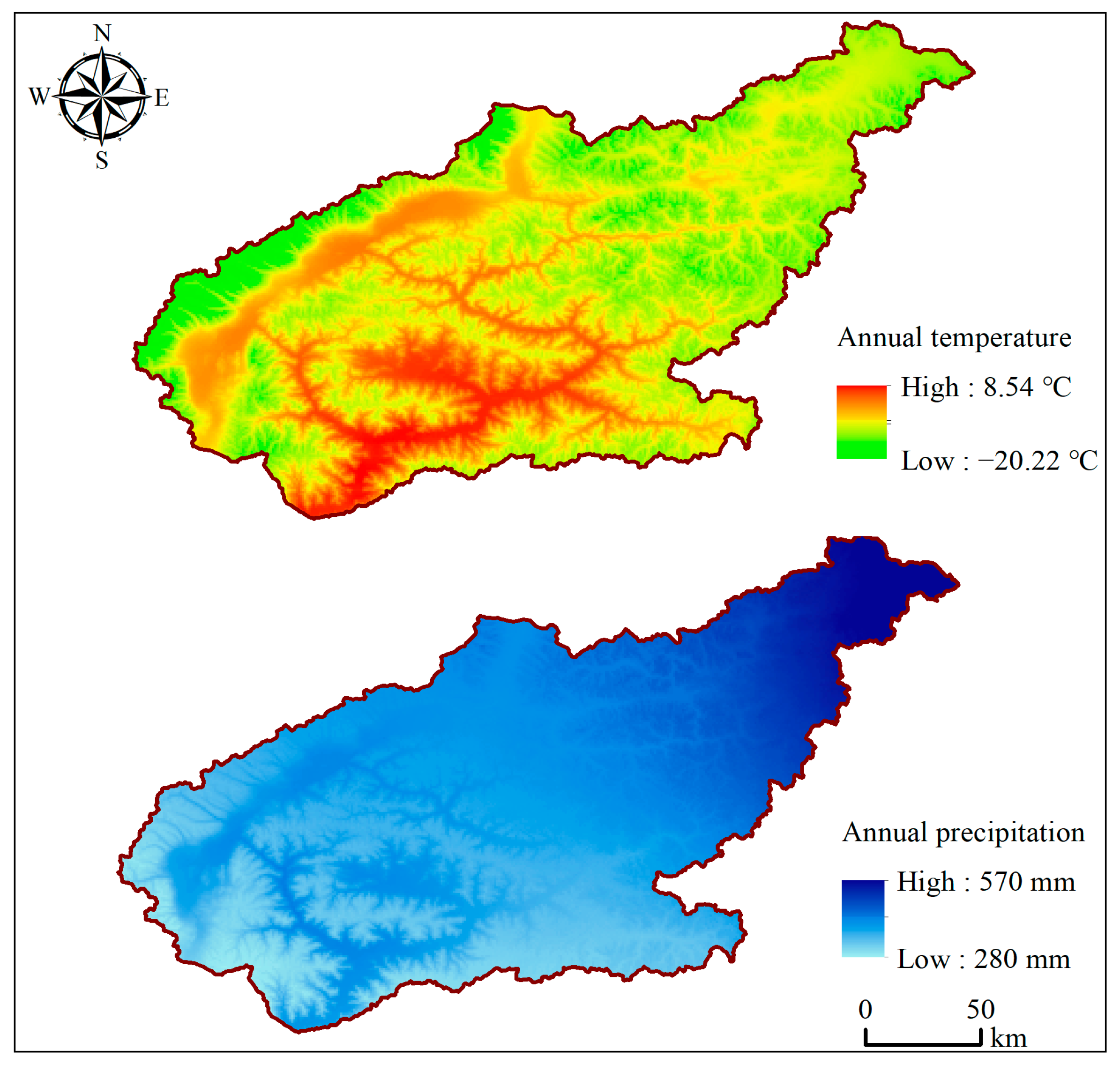
References
- Tilman, D.; Cassman, K.G.; Matson, P.A.; Naylor, R.; Polasky, S. Agricultural Sustainability and Intensive Production Practices. Nature 2002, 418, 671–677. [Google Scholar] [CrossRef] [PubMed]
- Kopittke, P.M.; Menzies, N.W.; Wang, P.; McKenna, B.A.; Lombi, E. Soil and the Intensification of Agriculture for Global Food Security. Environ. Int. 2019, 132, 105078. [Google Scholar] [CrossRef] [PubMed]
- Hollingsworth, J.A.; Ravishankar, E.; O’Connor, B.; Johnson, J.X.; DeCarolis, J.F. Environmental and Economic Impacts of Solar-Powered Integrated Greenhouses. J. Ind. Ecol. 2020, 24, 234–247. [Google Scholar] [CrossRef]
- Tong, X.; Zhang, X.; Fensholt, R.; Jensen, P.R.D.; Li, S.; Larsen, M.N.; Reiner, F.; Tian, F.; Brandt, M. Global Area Boom for Greenhouse Cultivation Revealed by Satellite Mapping. Nat. Food 2024, 5, 513–523. [Google Scholar] [CrossRef]
- Sun, H.; Wei, C.; Xu, W.; Yang, J.; Wang, X.; Qiu, Y. Characteristics of Salt Contents in Soils under Greenhouse Conditions in China. Environ. Sci. Pollut. Res. 2019, 26, 3882–3892. [Google Scholar] [CrossRef]
- Yuan, Y.; Zhang, X. Comparison of Agrochemicals Allocation Efficiency between Greenhouse and Open-Field Vegetables in China. Sci. Rep. 2021, 11, 12807. [Google Scholar] [CrossRef]
- Bai, Z.; Caspari, T.; Gonzalez, M.R.; Batjes, N.H.; Mäder, P.; Bünemann, E.K.; de Goede, R.; Brussaard, L.; Xu, M.; Ferreira, C.S.S.; et al. Effects of Agricultural Management Practices on Soil Quality: A Review of Long-Term Experiments for Europe and China. Agric. Ecosyst. Environ. 2018, 265, 1–7. [Google Scholar] [CrossRef]
- Alskaf, K.; Mooney, S.J.; Sparkes, D.L.; Wilson, P.; Sjögersten, S. Short-Term Impacts of Different Tillage Practices and Plant Residue Retention on Soil Physical Properties and Greenhouse Gas Emissions. Soil. Tillage Res. 2021, 206, 104803. [Google Scholar] [CrossRef]
- Chen, Z.; Tian, T.; Gao, L.; Tian, Y. Nutrients, Heavy Metals and Phthalate Acid Esters in Solar Greenhouse Soils in Round-Bohai Bay-Region, China: Impacts of Cultivation Year and Biogeography. Environ. Sci. Pollut. Res. 2016, 23, 13076–13087. [Google Scholar] [CrossRef]
- Gao, J.J.; Bai, X.L.; Zhou, B.; Zhou, J.B.; Chen, Z.J. Soil Nutrient Content and Nutrient Balances in Newly-Built Solar Greenhouses in Northern China. Nutr. Cycl. Agroecosyst. 2012, 94, 63–72. [Google Scholar] [CrossRef]
- Daliakopoulos, I.N.; Apostolakis, A.; Wagner, K.; Deligianni, A.; Koutskoudis, D.; Stamatakis, A.; Tsanis, I.K. Effectiveness of Trichoderma Harzianum in Soil and Yield Conservation of Tomato Crops under Saline Irrigation. Catena 2019, 175, 144–153. [Google Scholar] [CrossRef]
- Kianpoor Kalkhajeh, Y.; Huang, B.; Hu, W.; Ma, C.; Gao, H.; Thompson, M.L.; Bruun Hansen, H.C. Environmental Soil Quality and Vegetable Safety under Current Greenhouse Vegetable Production Management in China. Agric. Ecosyst. Environ. 2021, 307, 107230. [Google Scholar] [CrossRef]
- Han, J.; Luo, Y.; Yang, L.; Liu, X.; Wu, L.; Xu, J. Acidification and Salinization of Soils with Different Initial pH under Greenhouse Vegetable Cultivation. J. Soils Sediments 2014, 14, 1683–1692. [Google Scholar] [CrossRef]
- Zikeli, S.; Deil, L.; Möller, K. The Challenge of Imbalanced Nutrient Flows in Organic Farming Systems: A Study of Organic Greenhouses in Southern Germany. Agric. Ecosyst. Environ. 2017, 244, 1–13. [Google Scholar] [CrossRef]
- Fan, Y.; Zhang, Y.; Hess, F.; Huang, B.; Chen, Z. Nutrient Balance and Soil Changes in Plastic Greenhouse Vegetable Production. Nutr. Cycl. Agroecosyst. 2020, 117, 77–92. [Google Scholar] [CrossRef]
- Zhang, Z.; Sun, D.; Tang, Y.; Zhu, R.; Li, X.; Gruda, N.; Dong, J.; Duan, Z. Plastic Shed Soil Salinity in China: Current Status and next Steps. J. Clean. Prod. 2021, 296, 126453. [Google Scholar] [CrossRef]
- Wu, R.; Sun, H.; Xue, J.; Yan, D.; Liu, Y.; Gui, D.; Wang, X.; Yang, J. Acceleration of Soil Salinity Accumulation and Soil Degradation Due to Greenhouse Cultivation: A Survey of Farmers’ Practices in China. Environ. Monit. Assess. 2020, 192, 399. [Google Scholar] [CrossRef]
- Guo, J.H.; Liu, X.J.; Zhang, Y.; Shen, J.L.; Han, W.X.; Zhang, W.F.; Christie, P.; Goulding, K.W.T.; Vitousek, P.M.; Zhang, F.S. Significant Acidification in Major Chinese Croplands. Science 2010, 327, 1008–1010. [Google Scholar] [CrossRef] [PubMed]
- Li, S.; Lei, Y.; Zhang, Y.; Liu, J.; Shi, X.; Jia, H.; Wang, C.; Chen, F.; Chu, Q. Rational Trade-Offs between Yield Increase and Fertilizer Inputs Are Essential for Sustainable Intensification: A Case Study in Wheat–Maize Cropping Systems in China. Sci. Total Environ. 2019, 679, 328–336. [Google Scholar] [CrossRef]
- Wang, X.; Zou, C.; Gao, X.; Guan, X.; Zhang, Y.; Shi, X.; Chen, X. Nitrate Leaching from Open-Field and Greenhouse Vegetable Systems in China: A Meta-Analysis. Environ. Sci. Pollut. Res. 2018, 25, 31007–31016. [Google Scholar] [CrossRef]
- Herencia, J.F.; García-Galavís, P.A.; Maqueda, C. Long-Term Effect of Organic and Mineral Fertilization on Soil Physical Properties Under Greenhouse and Outdoor Management Practices. Pedosphere 2011, 21, 443–453. [Google Scholar] [CrossRef]
- Tian, K.; Hu, W.; Xing, Z.; Huang, B.; Jia, M.; Wan, M. Determination and Evaluation of Heavy Metals in Soils under Two Different Greenhouse Vegetable Production Systems in Eastern China. Chemosphere 2016, 165, 555–563. [Google Scholar] [CrossRef] [PubMed]
- Machado, R.M.A.; Serralheiro, R.P. Soil Salinity: Effect on Vegetable Crop Growth. Management Practices to Prevent and Mitigate Soil Salinization. Horticulturae 2017, 3, 30. [Google Scholar] [CrossRef]
- Ge, D.; Wang, Z.; Tu, S.; Long, H.; Yan, H.; Sun, D.; Qiao, W. Coupling Analysis of Greenhouse-Led Farmland Transition and Rural Transformation Development in China’s Traditional Farming Area: A Case of Qingzhou City. Land. Use Policy 2019, 86, 113–125. [Google Scholar] [CrossRef]
- Li, Y.; Ma, J.; Li, Y.; Jia, Q.; Shen, X.; Xia, X. Spatiotemporal Variations in the Soil Quality of Agricultural Land and Its Drivers in China from 1980 to 2018. Sci. Total Environ. 2023, 892, 164649. [Google Scholar] [CrossRef]
- Cao, Z.; Kühn, P.; He, J.-S.; Bauhus, J.; Guan, Z.-H.; Scholten, T. Calibration of Near-Infrared Spectra for Phosphorus Fractions in Grassland Soils on the Tibetan Plateau. Agronomy 2022, 12, 783. [Google Scholar] [CrossRef]
- He, G.; Shi, Z.; Fang, H.; Shi, L.; Wang, Y.; Yang, H.; Yan, B.; Yang, C.; Yu, J.; Liang, Q.; et al. Climate and Soil Stressed Elevation Patterns of Plant Species to Determine the Aboveground Biomass Distributions in a Valley-Type Savanna. Front. Plant Sci. 2024, 15, 1324841. [Google Scholar] [CrossRef]
- Biek, M.A.; Chung, W.; Mehta, K. Affordable Greenhouses: A Tool to Increase Farmers’ Adaptive Capacity to Climate Change. In Proceedings of the 2015 IEEE Global Humanitarian Technology Conference (GHTC), Seattle, DC, USA, 8–11 October 2015; pp. 321–325. [Google Scholar]
- Wang, Z.; Huang, L.; Shao, M. Spatial Variations and Influencing Factors of Soil Organic Carbon under Different Land Use Types in the Alpine Region of Qinghai-Tibet Plateau. Catena 2023, 220, 106706. [Google Scholar] [CrossRef]
- Wei, H.; Lv, C.; Liu, Y.; Yang, K. Spatial Distribution and Temporal Changes of Facility Agriculture on the Tibetan Plateau. Resour. Sci. 2019, 41, 1093–1101. [Google Scholar] [CrossRef]
- Wang, Z.; Gong, D.; Zhang, Y. Investigating the Effects of Greenhouse Vegetable Cultivation on Soil Fertility in Lhasa, Tibetan Plateau. Chin. Geogr. Sci. 2020, 30, 456–465. [Google Scholar] [CrossRef]
- Zhang, D.; Zhou, Z.; Zhang, B.; Du, S.; Liu, G. The Effects of Agricultural Management on Selected Soil Properties of the Arable Soils in Tibet, China. Catena 2012, 93, 1–8. [Google Scholar] [CrossRef]
- Dai, F.; Lv, Z.; Liu, G. Assessing Soil Quality for Sustainable Cropland Management Based on Factor Analysis and Fuzzy Sets: A Case Study in the Lhasa River Valley, Tibetan Plateau. Sustainability 2018, 10, 3477. [Google Scholar] [CrossRef]
- Gong, D.; Wang, Z.; Zhang, Y. Spatial-Temporal Variation Characteristics of Greenhouse-Vegetable Land in Lhasa of Tibet from 2008 to 2018. Trans. Chin. Soc. Agric. Eng. 2020, 36, 233–241. [Google Scholar] [CrossRef]
- Chen, W.; Yang, L.; Zeng, J.; Yuan, J.; Gu, T.; Liu, Z. Untangling the Increasing Elevation of Cropland in China from 1980 to 2020. Geogr. Sustain. 2023, 4, 281–293. [Google Scholar] [CrossRef]
- Huang, J.; Ebach, M.C.; Triantafilis, J. Cladistic Analysis of Chinese Soil Taxonomy. Geoderma Reg. 2017, 10, 11–20. [Google Scholar] [CrossRef]
- Chen, T.; Jiao, J.; Zhang, Z.; Lin, H.; Zhao, C.; Wang, H. Soil Quality Evaluation of the Alluvial Fan in the Lhasa River Basin, Qinghai-Tibet Plateau. Catena 2022, 209, 105829. [Google Scholar] [CrossRef]
- Polakowski, C.; Makó, A.; Sochan, A.; Ryżak, M.; Zaleski, T.; Beczek, M.; Mazur, R.; Nowiński, M.; Turczański, K.; Orzechowski, M.; et al. Recommendations for Soil Sample Preparation, Pretreatment, and Data Conversion for Texture Classification in Laser Diffraction Particle Size Analysis. Geoderma 2023, 430, 116358. [Google Scholar] [CrossRef]
- Shamrikova, E.V.; Vanchikova, E.V.; Kondratenok, B.M.; Lapteva, E.M.; Kostrova, S.N. Problems and Limitations of the Dichromatometric Method for Measuring Soil Organic Matter Content: A Review. Eurasian Soil. Sci. 2022, 55, 861–867. [Google Scholar] [CrossRef]
- Liu, J.; Gou, X.; Liu, J.; Yin, D.; Zhang, D. Comparative Analysis of the Drivers of Soil Organic Carbon, Total Nitrogen, and Phosphorus Stocks in Different Coniferous Plantations on the Eastern Tibetan Plateau. J. Soil. Sci. Plant Nutr. 2024, 24, 331–342. [Google Scholar] [CrossRef]
- Wan, H.-S.; Zhang, W.-C.; Wu, W.; Liu, H.-B. Environmental Factors Affecting Soil Organic Carbon, Total Nitrogen, Total Phosphorus under Two Cropping Systems in the Three Gorges Reservoir Area. J. Soils Sediments 2023, 23, 831–844. [Google Scholar] [CrossRef]
- Liu, X.; Ma, J.; Ma, Z.-W.; Li, L.-H. Soil Nutrient Contents and Stoichiometry as Affected by Land-Use in an Agro-Pastoral Region of Northwest China. Catena 2017, 150, 146–153. [Google Scholar] [CrossRef]
- Bargrizan, S.; Smernik, R.J.; Mosley, L.M. Development of a Spectrophotometric Method for Determining pH of Soil Extracts and Comparison with Glass Electrode Measurements. Soil. Sci. Soc. Am. J. 2017, 81, 1350–1358. [Google Scholar] [CrossRef]
- Peng, J.; Ji, W.; Ma, Z.; Li, S.; Chen, S.; Zhou, L.; Shi, Z. Predicting Total Dissolved Salts and Soluble Ion Concentrations in Agricultural Soils Using Portable Visible Near-Infrared and Mid-Infrared Spectrometers. Biosyst. Eng. 2016, 152, 94–103. [Google Scholar] [CrossRef]
- Qi, Y.; Darilek, J.L.; Huang, B.; Zhao, Y.; Sun, W.; Gu, Z. Evaluating Soil Quality Indices in an Agricultural Region of Jiangsu Province, China. Geoderma 2009, 149, 325–334. [Google Scholar] [CrossRef]
- Cardoso, E.; Vasconcellos, R.; Bini, D.; Miyauchi, M.; Alcantara, C.; Alves, P.; de Paula, A.; Nakatani, A.; Pereira, J.; Nogueira, M. Soil Health: Looking for Suitable Indicators. What Should Be Considered to Assess the Effects of Use and Management on Soil Health? Sci. Agric. 2013, 70, 219–303. [Google Scholar] [CrossRef]
- Jin, H.; Shi, D.; Lou, Y.B.; Zhang, J.; Ye, Q.; Jiang, N. Evaluation of the Quality of Cultivated-Layer Soil Based on Different Degrees of Erosion in Sloping Farmland with Purple Soil in China. Catena 2021, 198, 105048. [Google Scholar] [CrossRef]
- Zhang, L.; Xu, E. Effects of Agricultural Land Use on Soil Nutrients and Its Variation along Altitude Gradients in the Downstream of the Yarlung Zangbo River Basin, Tibetan Plateau. Sci. Total Environ. 2023, 905, 167583. [Google Scholar] [CrossRef]
- Jiang, Y.; Gao, J.; Yang, L.; Wu, S.; Dai, E. The Interactive Effects of Elevation, Precipitation and Lithology on Karst Rainfall and Runoff Erosivity. Catena 2021, 207, 105588. [Google Scholar] [CrossRef]
- Wang, J.; Zhang, T.; Fu, B. A Measure of Spatial Stratified Heterogeneity. Ecol. Indic. 2016, 67, 250–256. [Google Scholar] [CrossRef]
- Virtanen, P.; Gommers, R.; Oliphant, T.E.; Haberland, M.; Reddy, T.; Cournapeau, D.; Burovski, E.; Peterson, P.; Weckesser, W.; Bright, J.; et al. SciPy 1.0: Fundamental Algorithms for Scientific Computing in Python. Nat. Methods 2020, 17, 261–272. [Google Scholar] [CrossRef]
- IBM Corp. IBM SPSS Statistics for Windows, version 27.0; IBM Corp: Armonk, NY, USA, 2020.
- R Core Team. R: A Language and Environment for Statistical Computing; R Foundation for Statistical Computing: Vienna, Austria, 2024; Available online: https://www.R-project.org/ (accessed on 15 March 2024).
- Ren, X.; Zou, W.; Jiao, J.; Stewart, R.; Jian, J. Soil Properties Affect Crop Yield Changes under Conservation Agriculture: A Systematic Analysis. Eur. J. Soil. Sci. 2023, 74, e13413. [Google Scholar] [CrossRef]
- Yu, H.; Li, T.; Zhang, X. Nutrient Budget and Soil Nutrient Status in Greenhouse System. Agric. Sci. China 2010, 9, 871–879. [Google Scholar] [CrossRef]
- Fan, Y.; Zhang, Y.; Wan, M.; Hu, W.; Chen, Z.; Huang, B. Plastic Shed Production Intensified Secondary Soil Salinization in Perennial Fruit Production Systems. Agric. Ecosyst. Environ. 2021, 316, 107469. [Google Scholar] [CrossRef]
- Yang, L.; Huang, B.; Mao, M.; Yao, L.; Niedermann, S.; Hu, W.; Chen, Y. Sustainability Assessment of Greenhouse Vegetable Farming Practices from Environmental, Economic, and Socio-Institutional Perspectives in China. Environ. Sci. Pollut. Res. 2016, 23, 17287–17297. [Google Scholar] [CrossRef] [PubMed]
- Xun, W.; Zhao, J.; Xue, C.; Zhang, G.; Ran, W.; Wang, B.; Shen, Q.; Zhang, R. Significant Alteration of Soil Bacterial Communities and Organic Carbon Decomposition by Different Long-Term Fertilization Management Conditions of Extremely Low-Productivity Arable Soil in South China. Environ. Microbiol. 2016, 18, 1907–1917. [Google Scholar] [CrossRef]
- Islam, A.; Hussain, M.S. Mineralogical Characterization of Clay Fraction of Chalan Beel Soils of Bangladesh. J. Bangladesh Agric. Univ. 2008, 6, 253–260. [Google Scholar] [CrossRef]
- Gong, D.; Wang, Z.; Zhang, Y.; Hu, X.; Gu, C.; Wei, B. Soil Quality Change and Spatial Differentiation Characteristics of Greenhouses Land Soil in Lhasa River Valley. Acta Pedol. Sin. 2023, 60, 1582–1594. [Google Scholar] [CrossRef]
- Lv, H.; Zhao, Y.; Wang, Y.; Wan, L.; Wang, J.; Butterbach-Bahl, K.; Lin, S. Conventional Flooding Irrigation and over Fertilization Drives Soil pH Decrease Not Only in the Top- but Also in Subsoil Layers in Solar Greenhouse Vegetable Production Systems. Geoderma 2020, 363, 114156. [Google Scholar] [CrossRef]
- Andersen, J.H.; Fossing, H.; Hansen, J.W.; Manscher, O.H.; Murray, C.; Petersen, D.L.J. Nitrogen Inputs from Agriculture: Towards Better Assessments of Eutrophication Status in Marine Waters. Ambio 2014, 43, 906–913. [Google Scholar] [CrossRef]
- Cai, Z.; Wang, B.; Xu, M.; Zhang, H.; He, X.; Zhang, L.; Gao, S. Intensified Soil Acidification from Chemical N Fertilization and Prevention by Manure in an 18-Year Field Experiment in the Red Soil of Southern China. J. Soils Sediments 2015, 15, 260–270. [Google Scholar] [CrossRef]
- Ma, L.; Li, R.; Luan, H.; Tang, J.; Wang, L.; Huang, S. Temperature Matters More than Fertilization for Straw Decomposition in the Soil of Greenhouse Vegetable Field. Agronomy 2024, 14, 233. [Google Scholar] [CrossRef]
- Bosiacki, M.; Bednorz, L.; Fedeńczak, K.; Górecki, T.; Mizgajski, A.; Poniży, L.; Spiżewski, T. Soil Quality as a Key Factor in Producing Vegetables for Home Consumption—A Case Study of Urban Allotments in Gorzów Wielkopolski (Poland). Agronomy 2021, 11, 1836. [Google Scholar] [CrossRef]
- Wu, J.; Liang, J.; Björn, L.O.; Li, J.; Shu, W.; Wang, Y. Phosphorus-Arsenic Interaction in the ‘Soil-Plant-Microbe’ System and Its Influence on Arsenic Pollution. Sci. Total Environ. 2022, 802, 149796. [Google Scholar] [CrossRef] [PubMed]
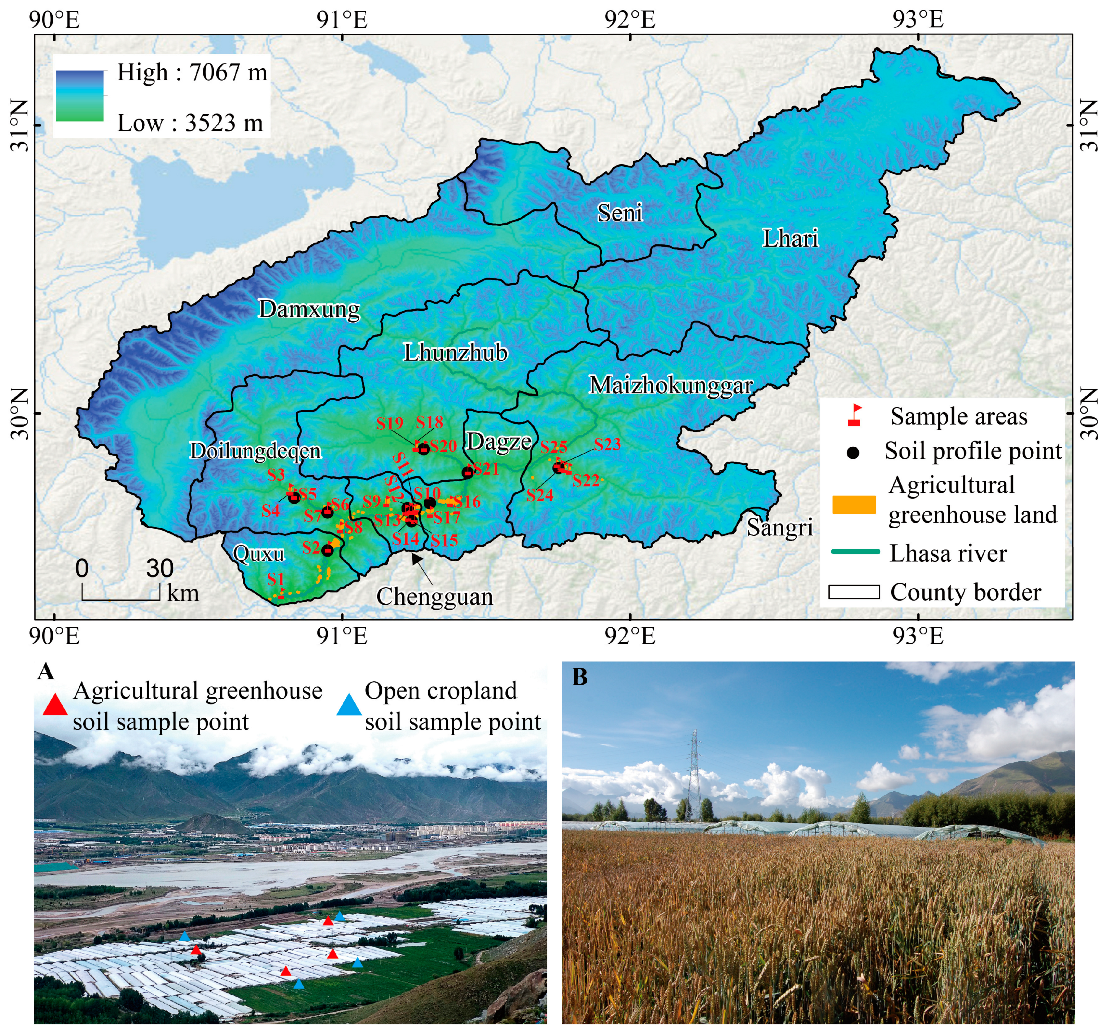
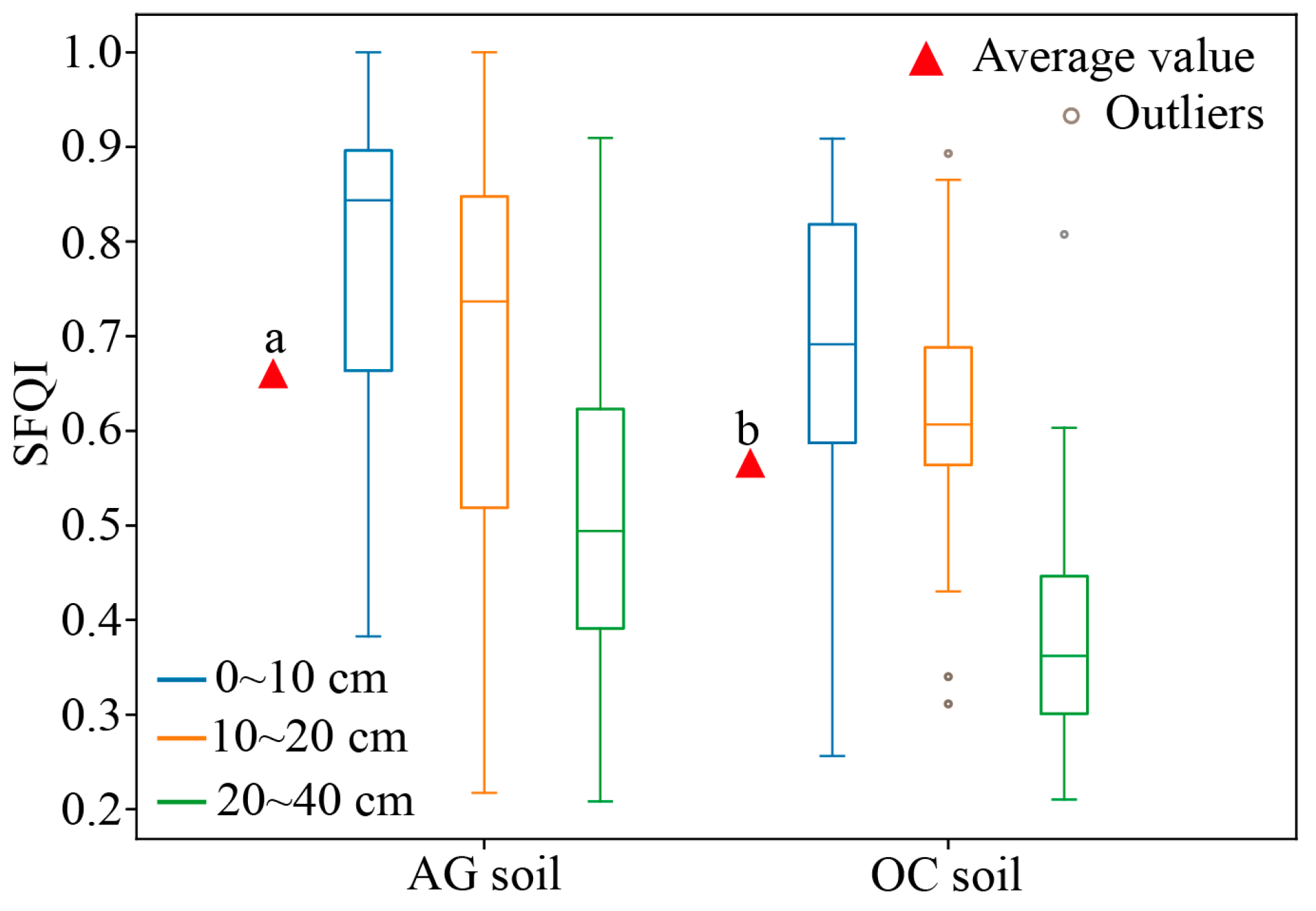

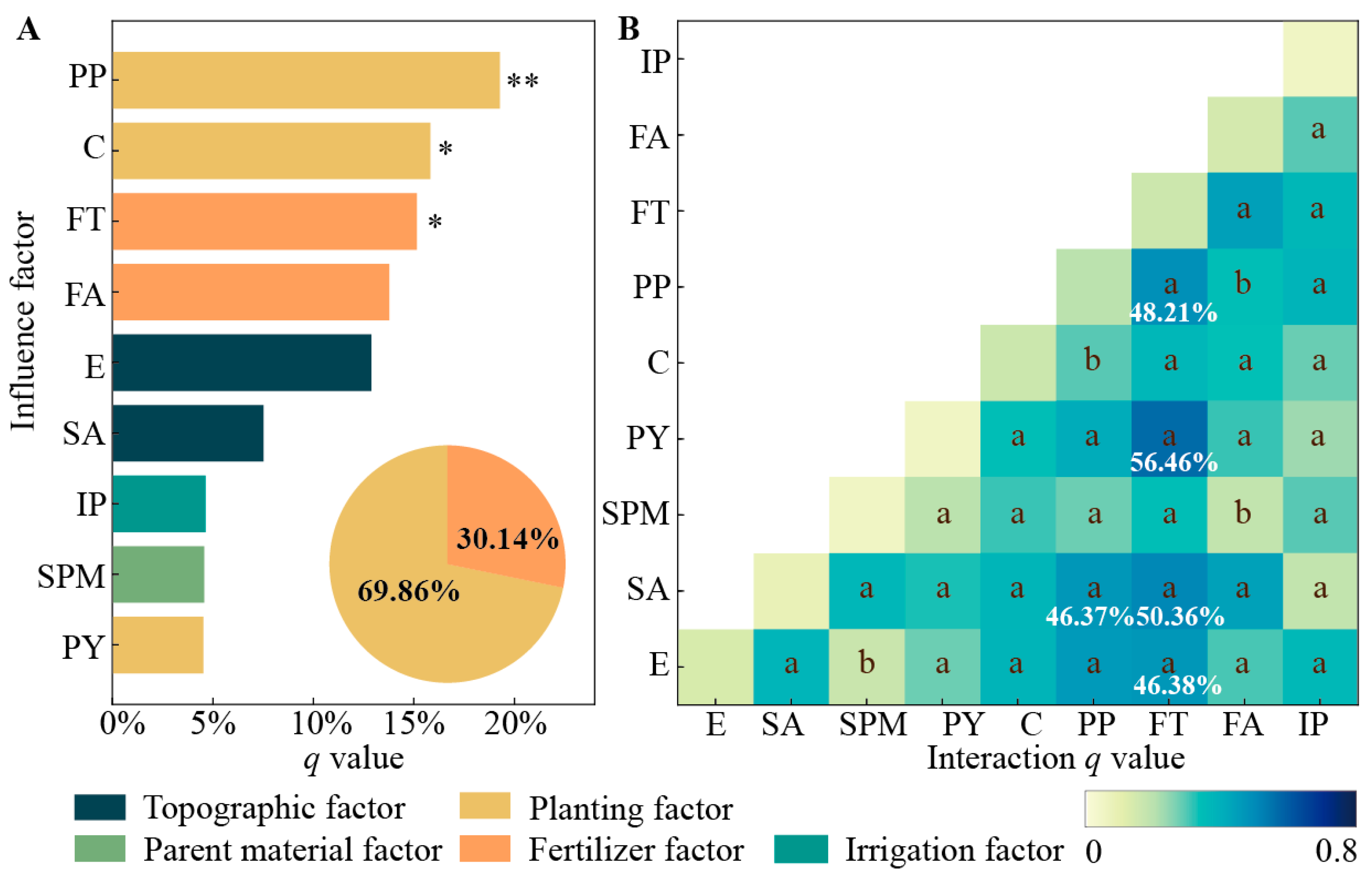
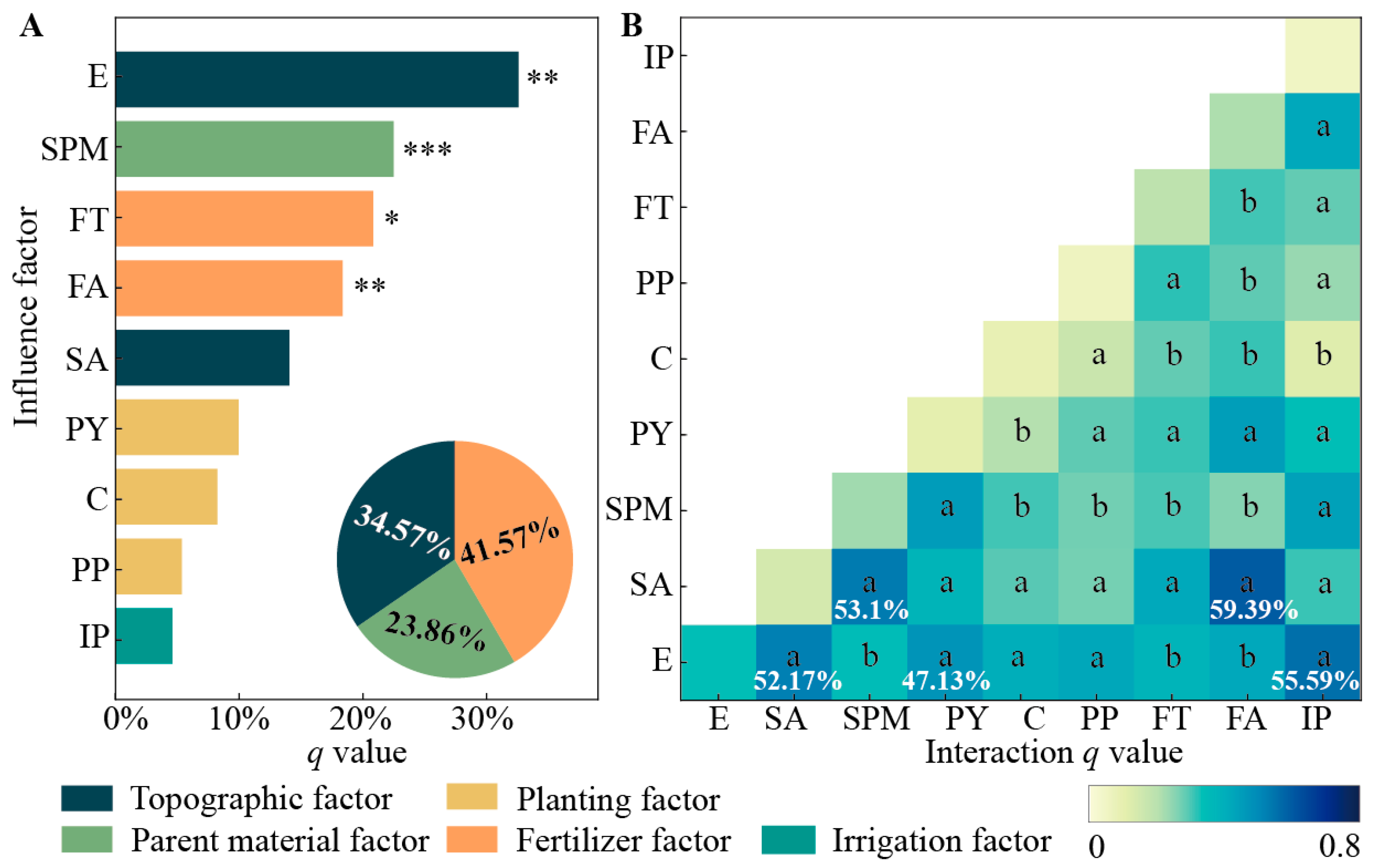
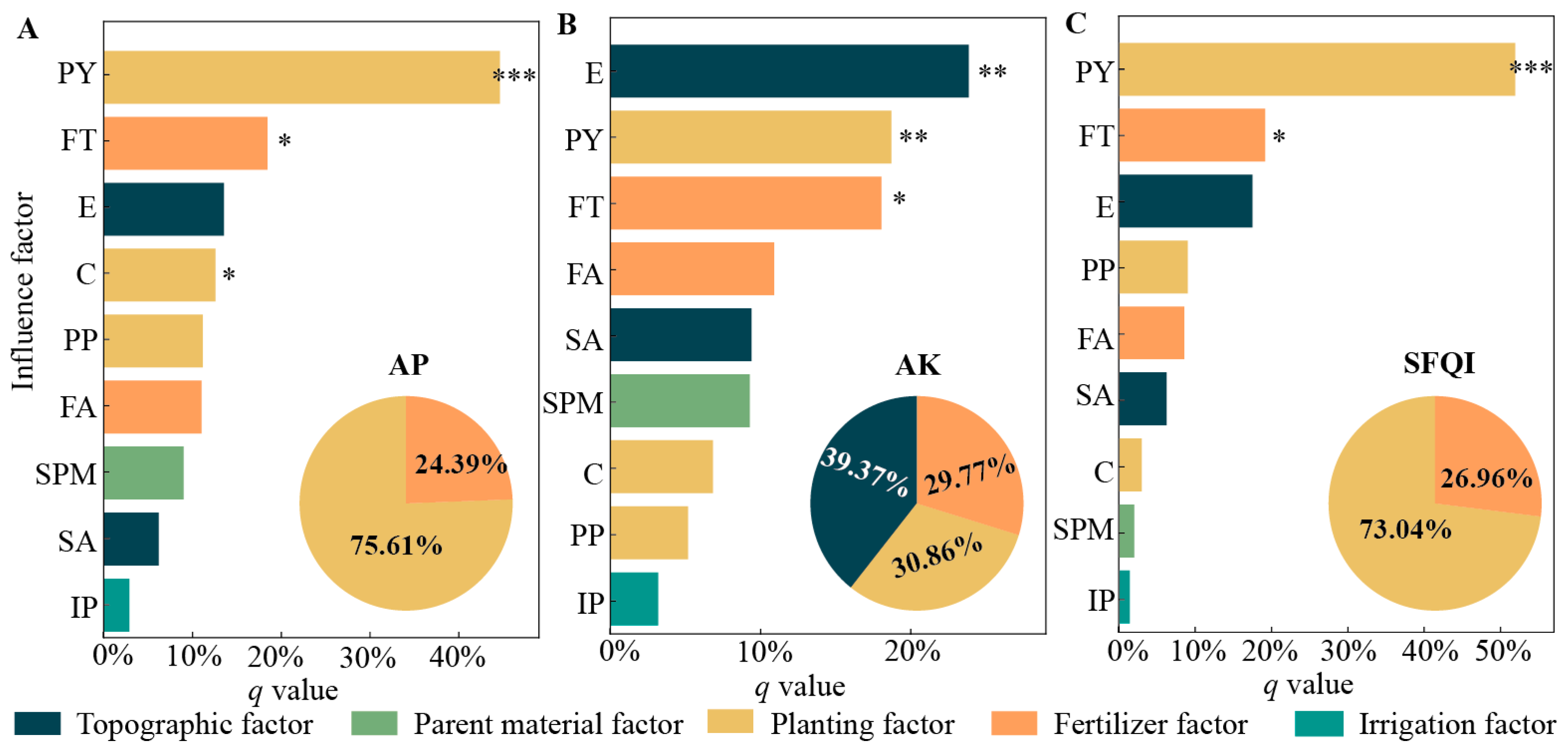
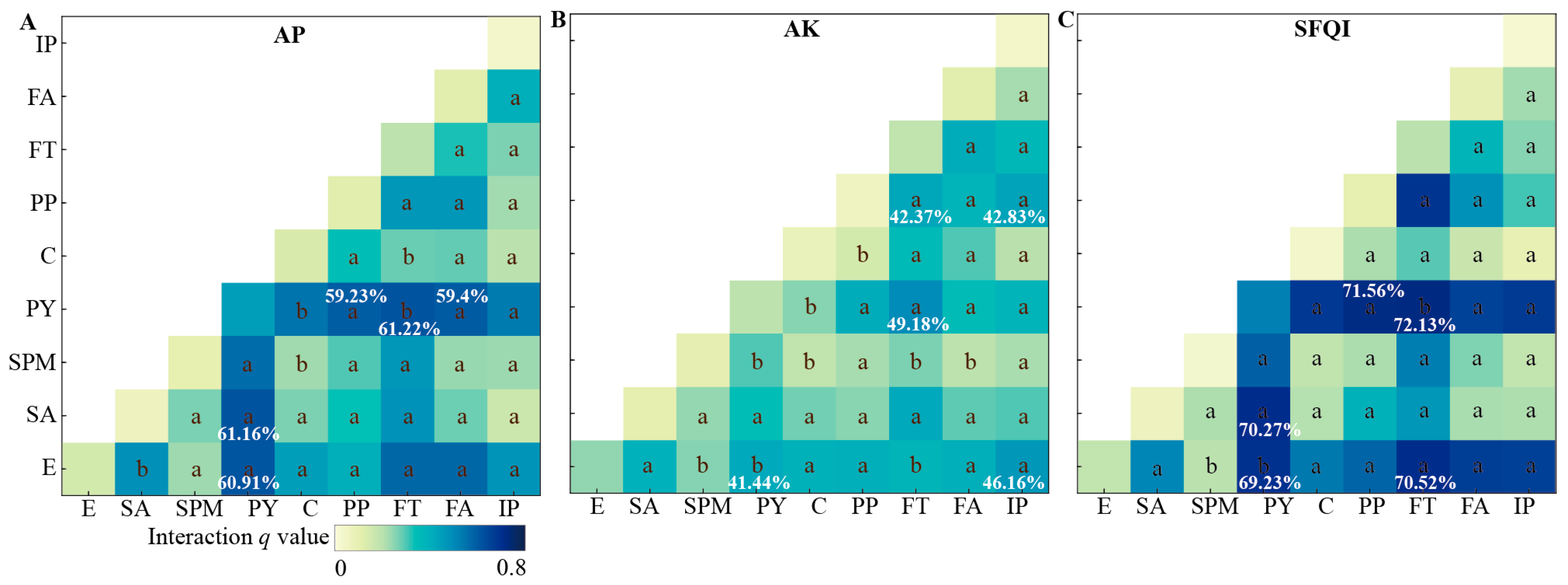
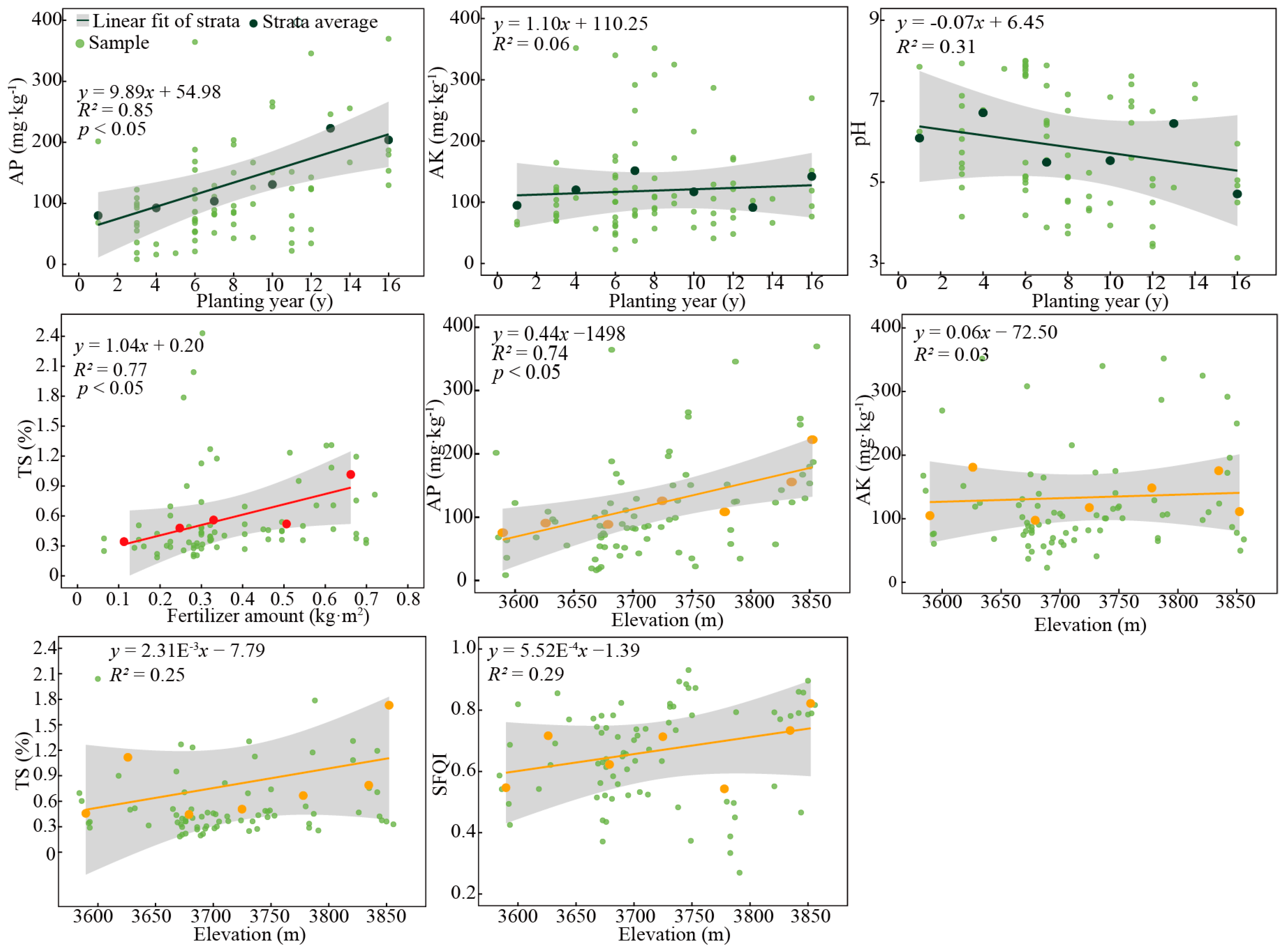
| Factor | Strata |
|---|---|
| Elevation | 3650–3600 m, >3600–3650 m, >3650–3700 m, >3700–3750 m, >3750–3800 m, >3800–3850 m, >3850–3900 m. These strata were assigned numerical codes 1, 2, 3, 4, 5, 6, and 7, with 7 strata in total. |
| Slope aspect | East, southeast, south, southwest, west, northwest, north, and northeast. These strata were assigned numerical codes 1, 2, 3, 4, 5, 6, 7, and 8, with 8 strata in total. |
| Soil parent material | Alluvial material, Fluvial deposit material, Alluvial—slope sediment material. These strata were assigned numerical codes 1, 2, and 3, with 3 strata in total. |
| Planting year | 1–3 y, 4–6 y, 7–9 y, 10–12 y, 13–15 y, 16–18 y. These strata were assigned numerical codes 1, 2, 3, 4, 5, and 6, with 6 strata in total. |
| Crop | Root vegetables, stem vegetables, leaf vegetables, fruity vegetables, miscellaneous. These strata were assigned numerical codes 1, 2, 3, 4, and 5, with 5 strata in total. |
| Planting pattern | Continuous cropping, crop rotation, intercropping, mono-cropping, mixture cropping. These strata were assigned numerical codes 1, 2, 3, 4, and 5, with 5 strata in total. |
| Fertilizer type | Low concentration, medium concentration, high concentration, low–low concentration, low–medium concentration, low–high concentration, medium–high concentration. These strata were assigned numerical codes 1, 2, 3, 4, 5, 6, and 7, with 7 strata in total. |
| Fertilizer amount | 0–0.15 kg/m2, >0.15–0.3 kg/m2, >0.3–0.45 kg/m2, >0.45–0.6 kg/m2, >0.6 kg/m2. These strata were assigned numerical codes 1, 2, 3, 4, and 5, with 5 strata in total. |
| Irrigation pattern | Sprinkler irrigation, flood irrigation, furrow irrigation, border irrigation. These strata were assigned numerical codes 1, 2, 3, and 4, with 4 strata in total. |
| Soil Indicators | Unit | AG Soil | OC Soil | ||||||
|---|---|---|---|---|---|---|---|---|---|
| Mean ± Std | Min | Max | C.V. (%) | Mean ± Std | Min | Max | C.V. (%) | ||
| Clay | % | 2.98 ± 1.58 a | 0.09 | 8.80 | 53.09 | 3.23 ± 1.37 a | 0.68 | 6.09 | 42.49 |
| Silt | % | 23.50 ± 11.46 a | 5.67 | 67.67 | 48.78 | 26.39 ± 13.20 a | 7.63 | 71.27 | 50.03 |
| Sand | % | 73.52 ± 12.89 a | 25.57 | 94.22 | 17.54 | 70.38 ± 14.17 a | 23.94 | 91.69 | 20.13 |
| pH | 5.90 ± 1.46 b | 3.10 | 8.15 | 24.8 | 7.07 ± 0.79 a | 5.70 | 8.25 | 11.24 | |
| TS * | % | 0.64 ± 0.66 a | 0.15 | 4.31 | 102.54 | 0.37 ± 0.17 b | 0.07 | 0.79 | 44.8 |
| SOM | g·kg−1 | 27.01 ± 13.77 a | 1.59 | 98.22 | 51 | 23.86 ± 7.92 b | 9.00 | 40.17 | 33.2 |
| TN * | g·kg−1 | 1.93 ± 1.14 a | 0.15 | 8.01 | 58.88 | 1.62 ± 0.67 b | 0.61 | 4.58 | 41.23 |
| TP * | g·kg−1 | 1.07 ± 0.49 a | 0.14 | 2.62 | 45.37 | 0.74 ± 0.23 b | 0.29 | 1.43 | 31.56 |
| TK | g·kg−1 | 35.52 ± 3.63 a | 25.52 | 46.39 | 10.21 | 35.30 ± 5.85 a | 17.11 | 47.68 | 16.58 |
| AN * | mg·kg−1 | 142.04 ± 83.71 a | 11.71 | 539.25 | 58.93 | 120.29 ± 54.64 b | 52.42 | 339.38 | 45.42 |
| AP * | mg·kg−1 | 113.50 ± 88.05 a | 3.83 | 555.45 | 77.58 | 42.87 ± 37.85 b | 3.83 | 183.62 | 88.28 |
| AK * | mg·kg−1 | 124.10 ± 86.76 a | 18.00 | 470.00 | 69.91 | 90.73 ± 44.56 b | 33.00 | 216.00 | 49.12 |
| Soil Indicators | |RC| Mean ± Std | RC > 0 | Percentage of RC > 0 | RC < 0 | Percentage of RC < 0 |
|---|---|---|---|---|---|
| Mean ± Std | Mean ± Std | ||||
| pH | 0.19 ± 0.15 | 0.17 ± 0.09 | 10.26% | −0.20 ± 0.15 | 89.74% |
| TS | 1.28 ± 2.61 | 1.84 ± 3.12 | 64.10% | −0.27 ± 0.18 | 35.90% |
| SOM | 0.38 ± 0.37 | 0.43 ± 0.43 | 64.10% | −0.28 ± 0.22 | 35.90% |
| TN | 0.44 ± 0.46 | 0.57 ± 0.54 | 58.97% | −0.25 ± 0.19 | 41.03% |
| TP | 0.55 ± 0.52 | 0.64 ± 0.54 | 80.77% | −0.18 ± 0.15 | 19.23% |
| AN | 0.40 ± 0.48 | 0.49 ± 0.57 | 61.54% | −0.24 ± 0.19 | 38.46% |
| AP | 2.45 ± 2.68 | 2.81 ± 2.73 | 85.90% | −0.22 ± 0.19 | 14.10% |
| AK | 0.76 ± 1.00 | 1.02 ± 1.18 | 62.82% | −0.30 ± 0.22 | 37.18% |
| SFQI | 0.32 ± 0.33 | 0.38 ± 0.37 | 70.51% | −0.18 ± 0.14 | 29.49% |
Disclaimer/Publisher’s Note: The statements, opinions and data contained in all publications are solely those of the individual author(s) and contributor(s) and not of MDPI and/or the editor(s). MDPI and/or the editor(s) disclaim responsibility for any injury to people or property resulting from any ideas, methods, instructions or products referred to in the content. |
© 2024 by the authors. Licensee MDPI, Basel, Switzerland. This article is an open access article distributed under the terms and conditions of the Creative Commons Attribution (CC BY) license (https://creativecommons.org/licenses/by/4.0/).
Share and Cite
Gong, D.; Wang, Z.; Zhang, Y.; Hu, X.; Wei, B.; Gu, C. Effects of Natural Factors and Production Management on the Soil Quality of Agricultural Greenhouses in the Lhasa River Valley, Tibetan Plateau. Agronomy 2024, 14, 2708. https://doi.org/10.3390/agronomy14112708
Gong D, Wang Z, Zhang Y, Hu X, Wei B, Gu C. Effects of Natural Factors and Production Management on the Soil Quality of Agricultural Greenhouses in the Lhasa River Valley, Tibetan Plateau. Agronomy. 2024; 14(11):2708. https://doi.org/10.3390/agronomy14112708
Chicago/Turabian StyleGong, Dianqing, Zhaofeng Wang, Yili Zhang, Xiaoyang Hu, Bo Wei, and Changjun Gu. 2024. "Effects of Natural Factors and Production Management on the Soil Quality of Agricultural Greenhouses in the Lhasa River Valley, Tibetan Plateau" Agronomy 14, no. 11: 2708. https://doi.org/10.3390/agronomy14112708
APA StyleGong, D., Wang, Z., Zhang, Y., Hu, X., Wei, B., & Gu, C. (2024). Effects of Natural Factors and Production Management on the Soil Quality of Agricultural Greenhouses in the Lhasa River Valley, Tibetan Plateau. Agronomy, 14(11), 2708. https://doi.org/10.3390/agronomy14112708






